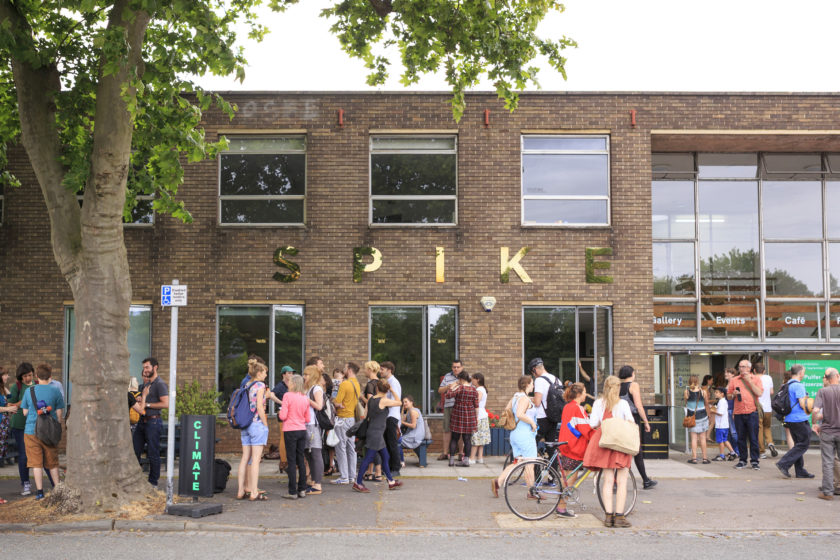This Summer, we have marked a significant milestone in its mission to become a Net Zero organisation, celebrating a series of achievements that put our ambitious Spike Green Futures goals firmly into action.
Spike Island is housed in an 80,000-square-foot creative hub situated in a historic tea-packing factory. The building not only contains the exhibition space, but also serves a sprawling community of creatives, including over 70 artist studios, creative business tenants, as well as Spike Print Studio – the largest open-access print studio in the South West – and the University of the West of England’s Fine Art BA (Hons), Art and Writing BA (Hons) and Fine Art MA programmes.
Art production, exhibitions, and the diverse array of events, creative projects, and programmes that take place across the building, all have significant carbon footprints.
Due to challenges like these, large exhibiting spaces need to take large steps in addressing the carbon footprint of the industry and taking strident measures to reduce the environmental impact. Spike Island’s commitment to sector-wide climate action was officiated in May 2025 when we were awarded Active Member status of the Gallery Climate Coalition (GCC) – an international network of over 1,500 arts and culture organisations working collectively to slash carbon emissions and promote zero-waste practices. In our sustainability statement, Spike Island sets out clear commitments: to reduce its carbon footprint by half by 2036 and to reach Net Zero in the 2040s.
In the past year, these pledges have translated into tangible action. In 2023 significant work took place in developing a decarbonisation strategy with engineers Max Fordham LLP and architects Connolly Wellingham Associates. In April 2025 the results of this strategy are taking shape as Spike Island completed a transformative capital project to replace its roof and install an array of 202 photovoltaic (PV) solar panels. As one of the largest providers of creative studio space in the South West, the building must be flexible and provide 24/7 access to its members. Combined with the age and energy inefficiency of the original building structure, this means that our energy consumption and costs are significant. This development is part of a much larger project of retrofitting the site, to improve energy efficiency, reduce heat loss by 50%, and transition to green energy sources – ensuring a more energy-efficient building and ending reliance on fossil fuels.
This investment is already having a tangible impact on the gallery’s footprint – since March 2025, 6,000 Kilograms of CO₂ emissions have been saved – the equivalent of planting 386 trees or the equivalent of the electricity used by three average UK homes for a year. This statistic will continue to rise as the panels do their job, eventually resulting in Spike Island being able to feed clean, renewable energy back into the national grid – over-exceeding our commitment to green electricity.
Spike Island’s actions go beyond infrastructure and policy: it extends directly into the realm of artistic practice. Each exhibition will be planned with the environmental cost of materials, transport, and production firmly in mind. In line with our promise to minimise transport emissions, Spike Island has pledged to prioritise sea freight wherever possible when moving artworks for exhibitions. According to research carried out by the Gallery Climate Coalition, the shipping of artwork for major exhibitions has been found to be one of the largest contributors to greenhouse gas emissions in the art sector. The gallery’s latest show – a survey exhibition of the late Guyanese-British artist Donald Locke (1930–2010) – has involved shipping 44 artworks across the Atlantic from the United States to Bristol, including large ceramic works and monumental paintings. This is an environmental challenge that all exhibiting galleries face, and Spike Island will continue where possible to cut down on harmful emissions created through freight.
Environmental practices are also changing at the local level with the expansion of the organisation’s material circularity drive. Rather than disposing of temporary materials once a show comes down, we now actively repurpose exhibition resources like plinths, vitrines, and frames — either reusing them for future projects or sharing them with other galleries and local creative initiatives. Even printed materials such as brochures and posters find a second life in community art programmes, collage schools, and craft groups across Bristol. All these efforts and more – including a voluntary and burgeoning gardening team made up artists and creative tenants – are headed up by the Spike Island Green team, a group of conscientious volunteers from all strands of Spike Island’s internal community.
As Spike Island looks ahead, its environmental goals remain ambitious but pragmatic: cutting emissions where it can, rethinking how art is produced made and exhibited, and cultivating an environmentally conscious community of makers and creators.
Spike Island’s Green Futures mission and decarbonisation actions are made possible with support from the John James Foundation, Nisbet Trust, WECA and Social Investment Business Group, Energy Resilience Fund.





